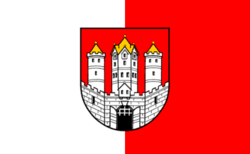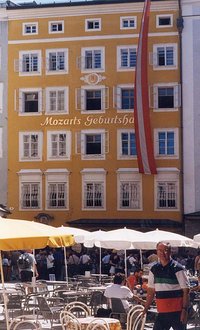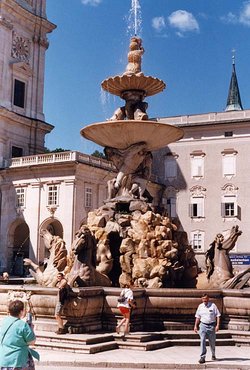Salzburg
|
|
- This page is for the city of Salzburg. For the surrounding state of Salzburg, see: Salzburg (state)
Salzburg (population 145,000 in 2003) is a city in western Austria and the capital of the federal state of Salzburg (population 520,000 in 2003). The geographic coordinates of Salzburg are Template:Coor dm.
The city is well-known for its baroque architecture, extensive history, and as a gateway to the Alps.
| Contents |
Setting
The city is located on the banks of the Salzach river, at the northern boundary of the Alps. The backdrop of mountains to the south contrasts with the rolling plains to the north. The closest alpine peak - the 1972m Untersberg - is only a few kilometers from the city center. The inner city, or old town, is dominated by its baroque towers and many churches. This area is surrounded by two smaller mountains, the Mönchsberg and Kapuzinerberg. The city is approximately 150km east of Munich, and 300km west of Vienna.
Early History
Salzburg.jpg
The first settlements at Salzburg were apparently begun by the Celts. Around 15 BC the separate settlements were merged into one city by the Romans. At this time the city was called Juvavum and was awarded the status of a Roman municipium in 45 AD.
Juvavum developed into an important town of the Roman province of Noricum. A Roman Catholic diocese was formed in the town around 700, which later became an archdiocese responsible for Bavaria.
The economic wealth of the town during this time was based on salt-mining. The salz in the town's name is the German word for salt. The town's river was a main artery for transporting salt mined in nearby mountains.
In 1077 the fortress was constructed under the order of Archduke Gebhard.
Until 1803, the Archbishop of Salzburg was the ruler of the city and the surrounding territory. Successive archbishop princes moulded the town, with the most influential being Wolf Dietrich who was largely responsible for the shape of the city today. His influence saw the creation of the towering Salzburg cathedral, the Mirabell Garden, and other landmarks.
Winter, 1731: The Expulsion of the Protestants
Not all of these Archbishop-Princes left a noble legacy. On October 31, 1731, the 214th Anniversary of Martin Luther's launching the Reformation by by nailing his 95 Theses of Contention to the Wittenberg Church door, Roman Catholic Archbishop Count Leopold von Firmian signed his Edict of Expulsion (not to be confused with many similar edicts of expulsion issued against the Jews in various cities in Europe), the Emigrationspatent, declaring that all Protestants recant their non-Catholic beliefs or be banished.
After signing the edict on the the 214th Anniversary of Reformation Day, Archbishop von Firmian declared that it was to be read publicly November 11, 1731, the 248th anniversary of Luther's baptism. Believing that his edict would drive away a few hundred troublesome infidels in the hills around the town, Firmian was surprised when 21,475 citizens professed on a public list their Protestant beliefs.
Land owners were given 3 months to sell their lands and leave. Cattle, sheep, furniture and land all had to be dumped on the market, and the Salzburgers received little money from the well-to-do Catholic allies of Von Firmian. Von Firmian himself confiscated much of their land for his own family, and ordered all Protestant books and Bibles burned. Many children aged 12 and under were seized to be raised as Roman Catholics. Yet those who owned land gained one key advantage: the three month deadline delayed their departure until after the worst of winter.
Non-owner farmers, tradesmen, laborers and miners were given only 8 days to sell what they could and leave. The first refugees marched north through the Alps in desperately cold temperatures and snow storms, seeking shelter in the few cities of Germany controlled by Protestant Princes. They sang hymns including A Mighty Fortress Is Our God, Joseph Schaitberger's Exile Song, Isaac Watts' Come, Gracious Spirit, Heavenly Dove, Martin Rinkart's Now Thank We All Our God, while their children walked or rode on wooden wagons loaded with baggage.
As they went, the exiles' savings were quickly drained away as they were set upon by both legal and illegal highwaymen, who seized taxes, tolls and payment for protection by soldiers from robbers.
The story of their plight spread quickly as their columns marched north. Goethe wrote the poem Hermann and Dorothea about the Salzburg exiles' march. Protestants and even some Catholics were horrified at the cruelty of their expulsion in winter, and the courage they had shown by not renouncing their faith. Slowly at first, they came upon towns that welcomed them and offered them aid. But there was no place where such a large number of refugees could settle.
Finally, in 1732 Lutheran King Frederick William I of Prussia accepted 12,000 Salzburger Protestant emigrants, who settled in areas of East Prussia that had been devastated by the plague twenty years before. Their new homelands were located in what today is northeastern Poland, the Kaliningrad Oblast, and Lithuania. Other, smaller groups made their way to the Banat region of modern Romania, to what is now Slovakia, to areas near Berlin and Hannover, and to the Netherlands.
On March 12, 1734, a small group of about sixty exiles from Salzburg who had traveled to London arrived in the British American colony of Georgia seeking religious freedom. Later in that year they were joined by a second group, and by 1741 a total of approximately 150 of the Salzburg exiles had founded the town of Ebenezer, Georgia on the Savannah River, about twenty five miles north of the city of Savannah. Other German speaking familiess - mostly Swiss Germans, Palatines and Swabians - also joined the Salzburgers at Ebenezer. In time, all of these Germanic people became known as "Salzburgers".
The Twentieth Century
Feb20526.JPG
During World War II, the city was lucky not to sustain heavy damage from Allied bombing runs. The towns bridges and the dome of the cathedral were demolished, however much of the town's baroque architecture remained intact. As a result, it is one of the few remaining examples of a town of its style.
In 1965, the movie The Sound of Music was filmed in Salzburg and the state of Salzburg. The movie was based on the true story of Maria von Trapp, a Salzburg-based nun who took up with an aristocratic family and fled German occupation. Although the film is relatively unknown to Austrians, the town draws a large percentage of visitors who wish to relive the movie by visiting the filming locations.
Notable Citizens
Feb20522.JPG
Feb20516.JPG
- The famous composer Wolfgang Amadeus Mozart was born and raised in Salzburg. His house of birth and residence are popular tourist attractions. His family is buried in a small church graveyard in the old town, and there are many monuments to "Wolferl" in the city.
- Christian Doppler, an expert on acoustic theory, was born in Salzburg. He is most renowned for his discovery of the Doppler effect.
- Josef Mohr was born in Salzburg, whom together with Franz Gruber, composed and wrote the text for Silent Night. As a priest in neighbouring Oberndorf he performed the song for the first time in 1818.
- Noted writer Stefan Zweig resided in Salzburg for about 15 years until his departure in 1934.
- Salzburg is also the birthplace of Hans Makart, a 19th century Austrian painter-decorator and national celebrity. Makartplatz (Makart Square) is named in his honour.
- Writer Thomas Bernhard was raised in Salzburg and spent part of his life there.
- Herbert von Karajan was a notable musician and conductor. He was born in Salzburg and died in 1989 in neighbouring Anif.
Events
SalzburgerAltstadt02.JPG
- The Salzburg Festival is a world-famous music festival that attracts visitors during the months of July and August each year. A smaller Salzburg Easter Festival is held around Easter each year.
- Salzburg was a candidate city for the 2006 and 2010 Olympic Winter Games. It was a favourite in its 2010 bid, but lost out to Vancouver. On January 24th, 2005, it was once again selected by the Austrian Olympic Committee as their candidate for the 2014 Winter Olympics.
- The Europrix multimedia award takes place in Salzburg.
Tourist Attractions
SalzburgerAltstadt01.JPG
Salzburg is considered a tourist favourite, with the number of tourists outnumbering locals by a large margin in peak times.
- Skiing is a key attraction during Winter. Salzburg itself has no skiing facilities, but it acts as a gateway to many skiing areas to the south. During the Winter months its airport receives a huge number of charter flights from around Europe.
- The baroque "old town", with highlights including the Salzburg Cathedral, and the Mirabell Garden.
- The Salzkammergut is an area of lakes in the Salzburg state, east of the city, that is quite well-known.
- The Untersberg is next to the city, straddling the German-Austrian border, and on a clear day provides panoramic views of the city and the Alps.
- Eagle's Nest, Hitler's retreat, is in nearby Berchtesgaden.
Transport
Feb20532.JPG
The city is serviced by comprehensive rail connections, with frequent east-west trains servicing Vienna, Munich, Innsbruck, and Zürich; including twice-daily high-speed ICE services. The city also acts as a hub for south-bound trains through the Alps into Italy.
The Salzburg Airport has scheduled flights to key European cities such as Frankfurt, Vienna, London, Amsterdam and Zürich. The majority of flights, however, are charter flights.
External links
- Stadt Salzburg (http://www.stadt-salzburg.at/) - Official government website.
- Salzburger Nachrichten (http://www.salzburg.com/) - the daily newspaper.
- Salzburg 2014 (http://www.salzburg2014.com) - 2014 Olympic bid website
- SALZBURGnet (http://www.salzburgnet.com/) - Very extensive information page to the city Salzburg, the country Salzburg and the Salzkammergut (Lake District).
- http://www.salzburg-night.at/multilingual.asp?lan=en, restaurant guide and event calendar
- Georgia Salzburger Society (http://www.georgiasalzburgers.com/) -- The website of the Georgia Salzburger Society, descendents of the refugees who settled there after their expulsion in 1731.bg:Залцбург
cs:Salzburg de:Salzburg eo:Salzburg fr:Salzbourg ja:ザルツブルク nl:Salzburg pl:Salzburg pt:Salzburgo ro:Salzburg sl:Salzburg



